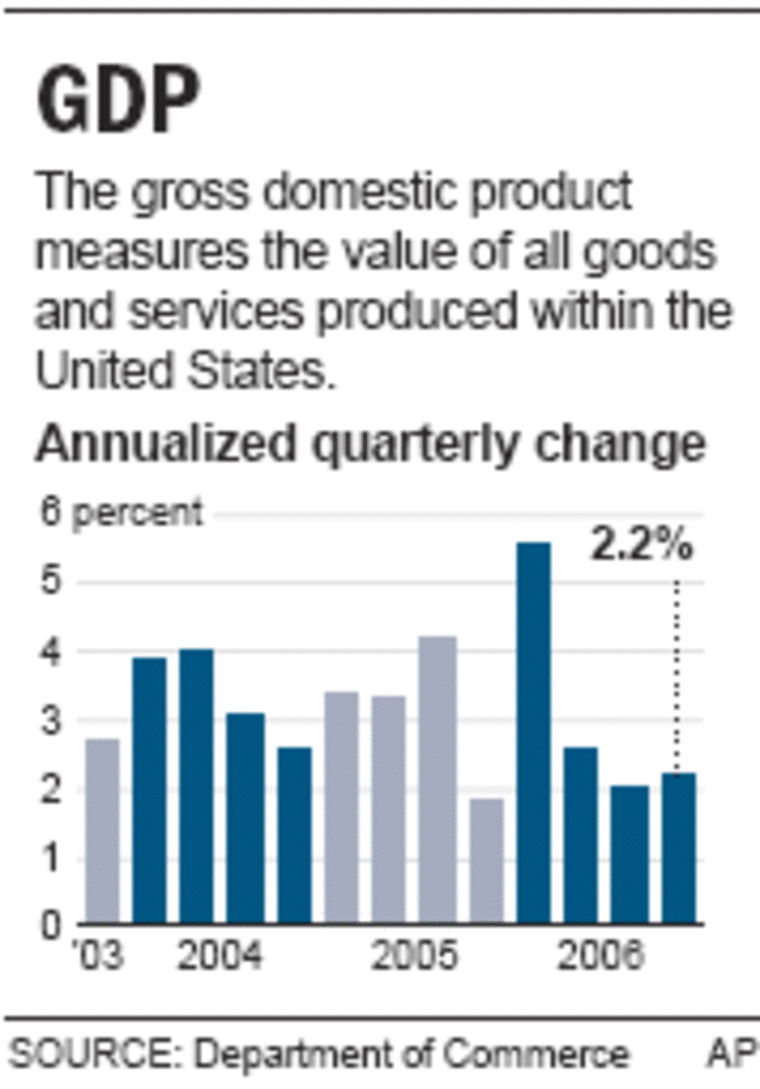The economy grew at a sluggish 2.2 percent pace in the final quarter of last year, much slower than initially estimated, in the sort of unusually large revision that has happened only seven times in the last 30 years.
The latest reading on the gross domestic product, released Wednesday by the Commerce Department, came a day after stocks on Wall Street and around the globe took a nosedive. The new figures showed the economy in a considerably weaker state than the government first estimated when it said the expansion in the last three months of 2006 was at a 3.5 percent pace. The principle reason: Businesses tightened their belts amid fallout from the troubled housing and automative sectors.
The new GDP figure for the October-to-December quarter was a tad slower than the 2.3 percent growth rate economists were forecasting and clearly less sunny than that original estimate. The GDP, which measures the value of all goods and services produced within the United States, is the best overall barometer of economic health.
Although the fourth quarter’s showing marked a slight improvement from the third quarter’s mediocre 2 percent growth rate, it didn’t alter the overall picture that economic activity in both quarters was restrained by the housing slump and the ailing automotive sector.
Investment in home building in the fourth quarter was slashed at a 19.1 percent pace, the steepest decline in 15 years.
Ken Mayland, president of ClearView Economics likened the fourth-quarter’s showing as part of a “mid-course breather” reflecting a period of temporary listlessness, not a slide toward recession. “I think it is unfolding as a slowdown, not a turndown — meaning recession,” he said.
The downgrading of the fourth-quarter GDP estimate meant that the economy for all of 2006 ended up growing by 3.3 percent, down slightly from 3.4 percent first estimated. Even so, the new figure still marked the best annual performance in two years.

Business retrenchment was a key factor behind the lower GDP estimate for the fourth quarter. Businesses, worried that extra supplies of goods might get out of whack with customer demand, ended up investing much less than previously thought in their inventories. That shaved 1.35 percentage points off fourth-quarter GDP, the most in 1 1/2 years.
Companies also ended up cutting back on other spending and investment in the fourth quarter, including equipment and software and new plants and other commercial buildings.
Consumers, a major force shaping overall economic activity, boosted spending at a 4.2 percent pace in the final quarter of last year. That was brisk — and up considerably from a 2.8 percent pace in the prior quarter. But it also was slightly less than the 4.4 percent growth rate first estimated for the final quarter of last year. That also played a role in the GDP downgrade in the fourth quarter.
Such a big revision in fourth quarter GDP — to a 2.2 percent pace from the initial 3.5 percent pace — was unusual. The government said the average revision is much smaller — 0.5 percentage point. “A revision of 1.3 percentage points or larger has occurred only seven times in 30 years,” it said.
The anxiety in the stock market came as investors fretted that the U.S. and Chinese economies may be stumbling. Their anxiety was partly stoked by an earlier warning from ex-Federal Reserve Chairman Alan Greenspan that it was possible the U.S. economy could slide into a recession this year.
Many economists say the odds of that happening are low. The biggest risk to short-circuiting the expansion, which started in late 2001, is a worse than expected housing slump.
Still, analysts predict the economy will stay sluggish for a while, reflecting continued strain from the ailing housing sector. The economy should clock in at a 2.5 percent pace in the current January-to-March quarter, edge up to a 2.6 percent pace in the April-to-June period and then to 2.9 percent in the following three months, according to projections by the National Association for Business Economics.
The new GDP report comes against a backdrop of Democrats and Republicans arguing contrasting points on the extent to which the economic expansion is helping most Americans. The Bush administration says most Americans are better off, while Democrats accuse President Bush of not doing enough to help narrow the gap between low-and high-income workers.
The public has concerns about the president’s economic stewardship: 42 percent approve, while 55 percent disapprove, according to an AP-Ipsos poll.
Wednesday’s GDP report also showed that underlying inflation is calming down, which is good news for consumers, businesses and the overall economy.
An inflation gauge tied to the GDP report showed that core prices — excluding food and energy — rose at a rate of 1.9 in the final quarter of last year. That was less than initially estimated and down from a 2.2 percent pace in the third quarter.
With inflation improving, the Federal Reserve, which had steadily boosted interest rates for two years, has left them alone since August. Economists believe rates could stay where they are for much of this year.